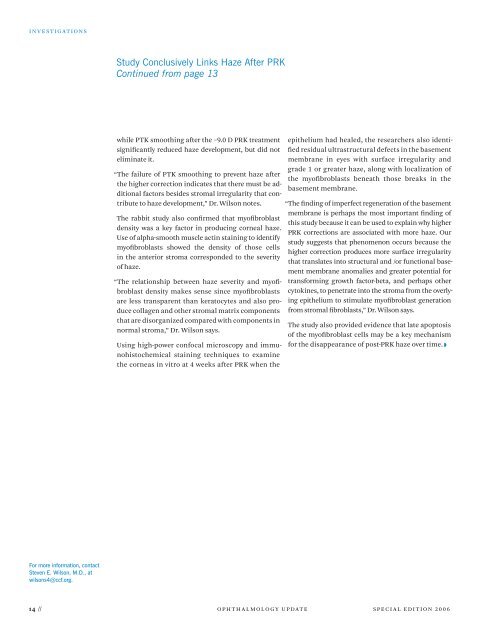Ophthalmology Update - Cleveland Clinic
Ophthalmology Update - Cleveland Clinic
Ophthalmology Update - Cleveland Clinic
Create successful ePaper yourself
Turn your PDF publications into a flip-book with our unique Google optimized e-Paper software.
i n v e s t i g a t i O n s<br />
For more information, contact<br />
Steven E. Wilson, M.D., at<br />
wilsons4@ccf.org.<br />
Study Conclusively Links Haze After PRK<br />
Continued from page 13<br />
while ptK smoothing after the –9.0 d prK treatment<br />
significantly reduced haze development, but did not<br />
eliminate it.<br />
“the failure of ptK smoothing to prevent haze after<br />
the higher correction indicates that there must be additional<br />
factors besides stromal irregularity that contribute<br />
to haze development,” dr. Wilson notes.<br />
the rabbit study also confirmed that myofibroblast<br />
density was a key factor in producing corneal haze.<br />
Use of alpha-smooth muscle actin staining to identify<br />
myofibroblasts showed the density of those cells<br />
in the anterior stroma corresponded to the severity<br />
of haze.<br />
“the relationship between haze severity and myofibroblast<br />
density makes sense since myofibroblasts<br />
are less transparent than keratocytes and also produce<br />
collagen and other stromal matrix components<br />
that are disorganized compared with components in<br />
normal stroma,” dr. Wilson says.<br />
Using high-power confocal microscopy and immunohistochemical<br />
staining techniques to examine<br />
the corneas in vitro at 4 weeks after prK when the<br />
epithelium had healed, the researchers also identified<br />
residual ultrastructural defects in the basement<br />
membrane in eyes with surface irregularity and<br />
grade 1 or greater haze, along with localization of<br />
the myofibroblasts beneath those breaks in the<br />
basement membrane.<br />
“the finding of imperfect regeneration of the basement<br />
membrane is perhaps the most important finding of<br />
this study because it can be used to explain why higher<br />
prK corrections are associated with more haze. Our<br />
study suggests that phenomenon occurs because the<br />
higher correction produces more surface irregularity<br />
that translates into structural and /or functional basement<br />
membrane anomalies and greater potential for<br />
transforming growth factor-beta, and perhaps other<br />
cytokines, to penetrate into the stroma from the overlying<br />
epithelium to stimulate myofibroblast generation<br />
from stromal fibroblasts,” dr. Wilson says.<br />
the study also provided evidence that late apoptosis<br />
of the myofibroblast cells may be a key mechanism<br />
for the disappearance of post-prK haze over time.<br />
// O p h t h a l m O l O g y U p d a t e s p e c i a l e d i t i O n 2 0 0 6
















